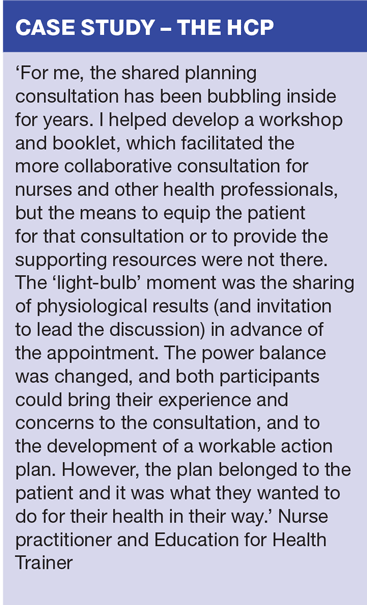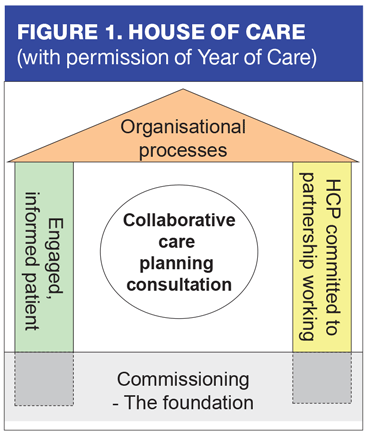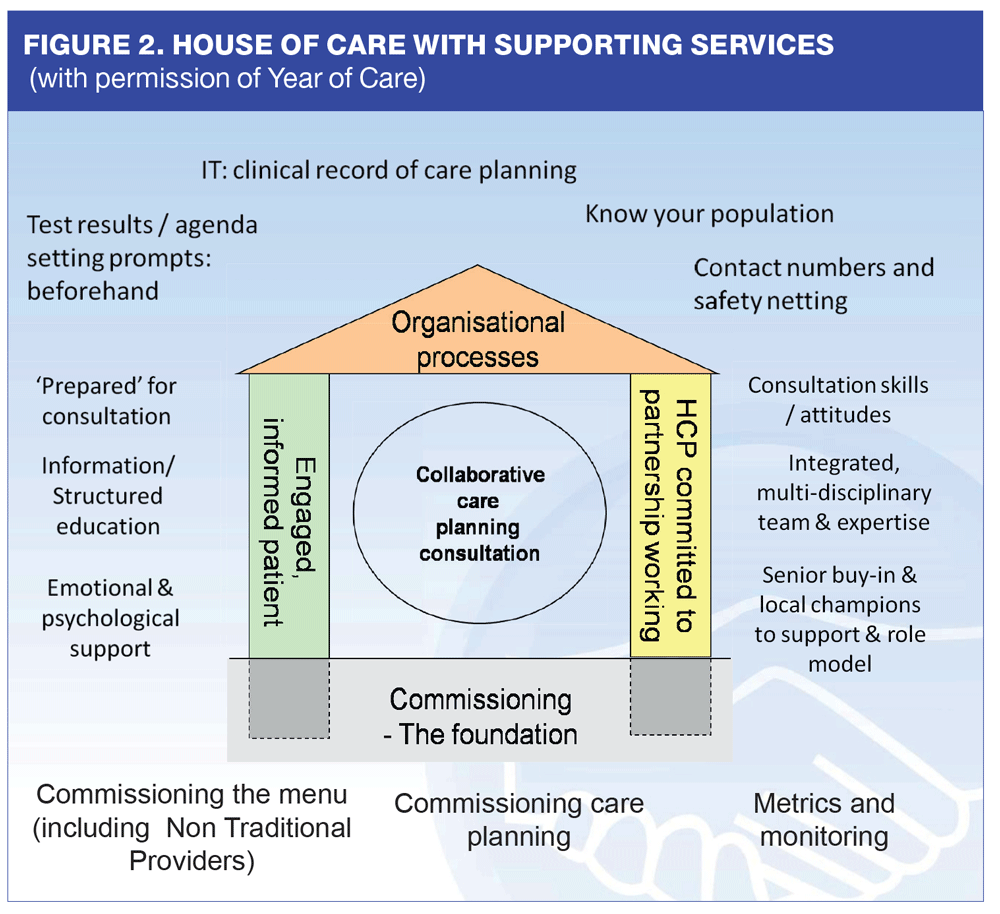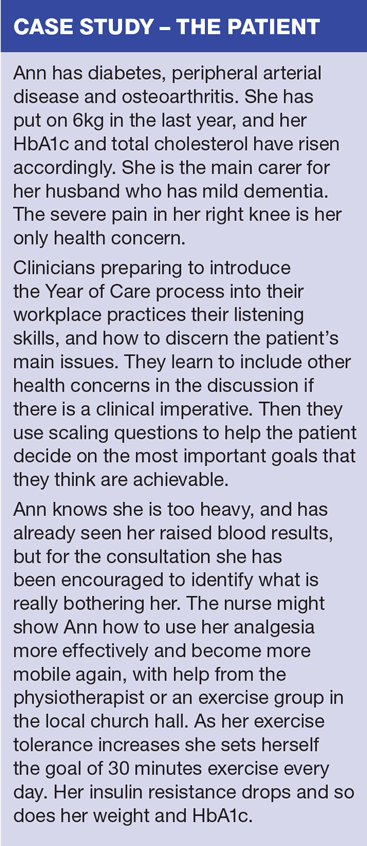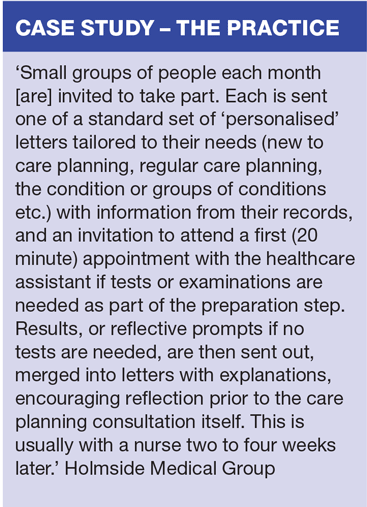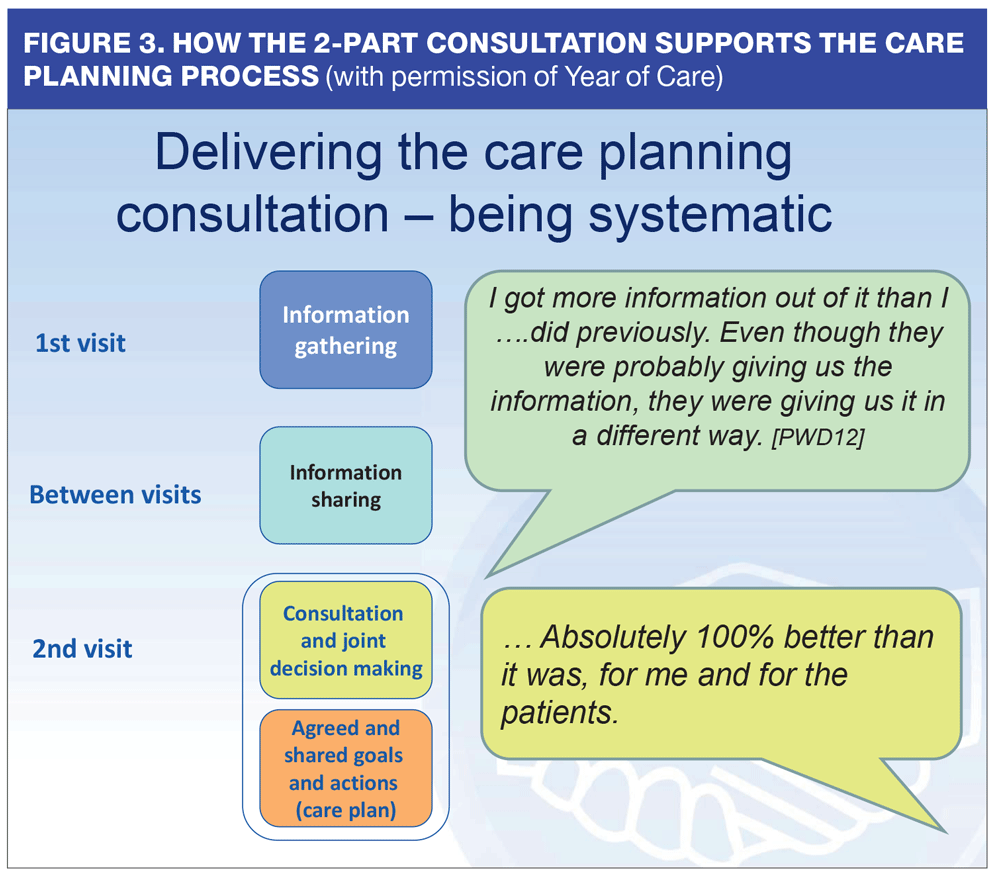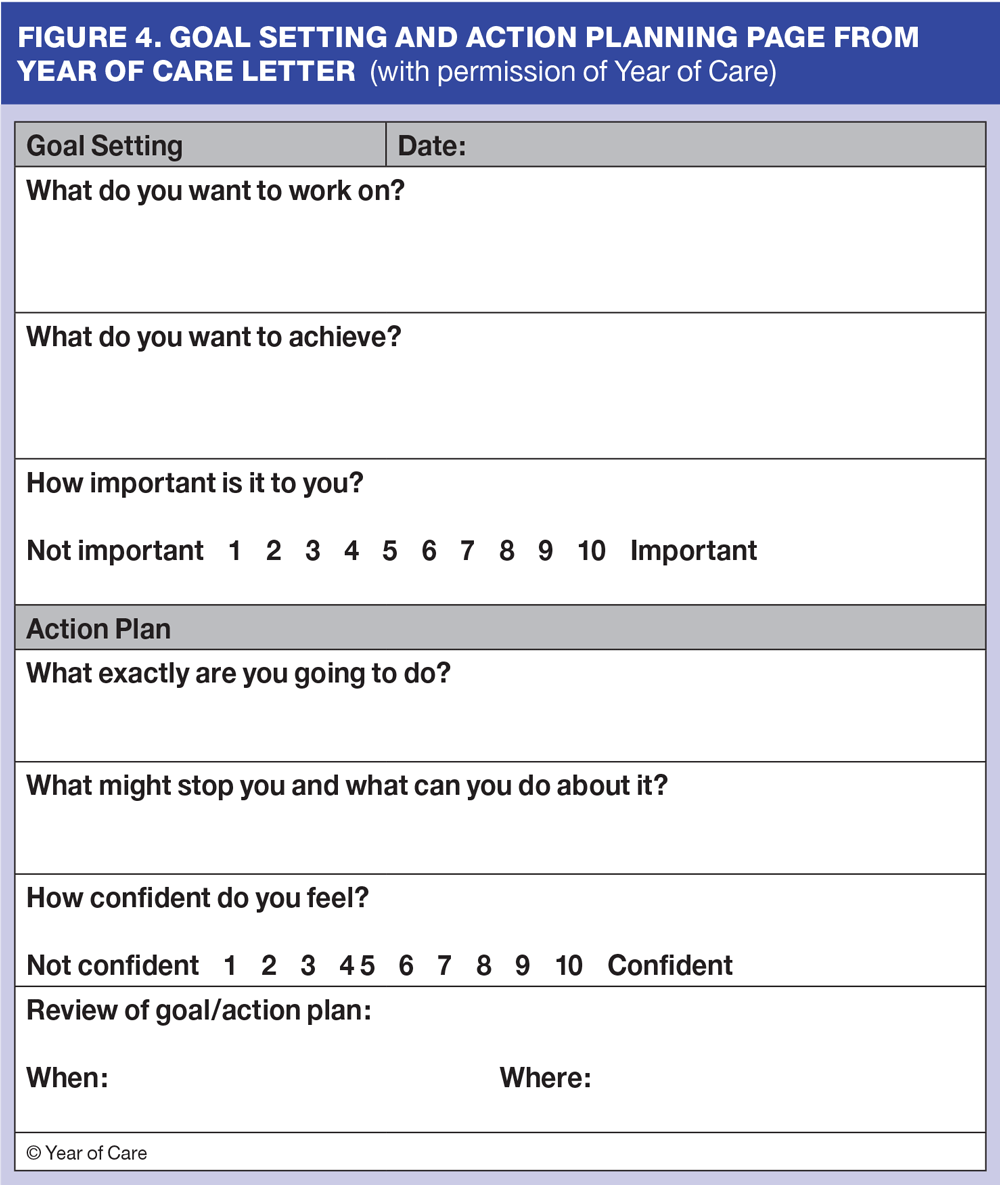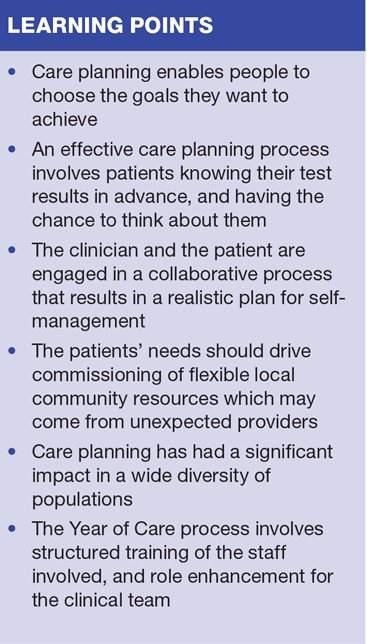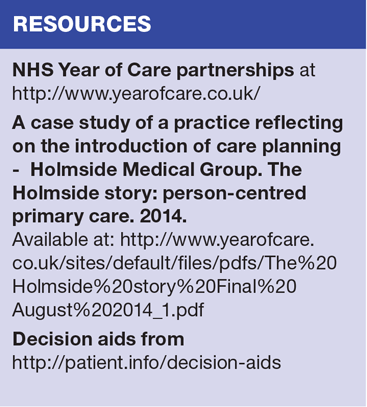The Year of Care — planning together for effective care
Liz Bryant
Liz Bryant
RGN MMedEd
Nurse Practitioner and Trainer for Year of Care
Lindsay Oliver
BSc(Hons)
National Director Year of Care Partnerships
People with long-term conditions manage their health problems themselves for the great majority of the time, and their access to healthcare professionals is relatively limited. So wouldn’t it be brilliant if we could equip them to make a real difference to their health? The Year of Care programme is turning vision into reality
For over twenty years health professionals, think tanks and policy makers have been aware that the management of long-term conditions (LTC) absorbs a huge amount of the health budget – 55% of GP appointments, 64% of out-patient appointments and 70% of in-patient bed days – without much success in reducing the burden on either patients or finances.1 About 50% of people in the UK aged over 50 have a LTC, and older people often have multiple conditions. They manage these health problems themselves for the vast majority of time, with limited access to health care professionals. Clinicians have been trained to treat them when they fall ill, but not often to give them the skills and resources to manage their own health.
The international evidence base for improving care in LTC is exemplified in the Chronic Care Model,2 where a partnership between an engaged empowered patient and an organised proactive system produces better outcomes. Patient-focussed care and care planning is a central theme of government policy,1 but effective delivery of sustainable change has proved elusive.3 Practice nurses, who have been at the forefront of chronic disease management in primary care for the last 25 years, will recognise this and will have witnessed the difficulties at first hand.
WHERE AND WHY THE YEAR OF CARE
The Year of Care programme set out to provide a better way of empowering people with diabetes to manage their own health, thus improving their quality of life and health outcomes, and reducing health costs.4 Initially, this was a test of whether the chronic care model for diabetes could be implemented in routine general practice, with a vision that it could then be extended to cover other LTCs.
During the pilot scheme it became clear that health professionals and communities, as well as individual patients, benefitted. The way in which the programme was implemented and supported was also found to be crucial to its success – ‘not just what you do but how you do it’. The approach is now routinely applied to people with LTCs, including those with multi-morbidity.
WHOLE SYSTEM CHANGE
The two elements essential for an effective programme are:
- Collaborative planning consultations
- Local resources that can support healthy actions and increase self-management.
These elements will be missing if:
- Patients are not informed and involved
- Health professionals fail to listen and share
- Commissioning and management structures are inflexible and unresponsive
- IT systems that sustain the process are lacking.
The Year of Care team proposed a model – the House of Care – which illustrates the requirements necessary to deliver the programme [Figure 1]. The House exists to facilitate its centre – the collaborative consultation. The foundation is commissioning, to identify and meet the pre-requisites of the process. The left wall represents the engaged, informed patient and the right wall represents the healthcare professional committed to partnership working. The roof symbolises the information technology and other systems needed to support the efficient running of the programme. Figure 2 illustrates what may need to be thought about for each part of the ‘House’.
Several initiatives have proved unsustainable because they were lacking one or more of these elements.5 Most Year of Care projects have faced challenges in getting all the pieces to fall into place at once, but the results have been effective enough to spur nurses and doctors, managers and CCGs into greater efforts to continue.6
Three areas – Calderdale and Kirklees, Tower Hamlets and North of Tyne – piloted the programme from 2007 and continue to use it.4 The Year of Care Partnerships are training and equipping other primary and secondary care organisations to follow suit. Practices that have adopted this process have overhauled the way they deliver annual reviews, and no-one more so than the health care assistants and nurses who run the reviews.
IT STARTS WITH US
At the centre of the house is the consultation. This is where patient and health professional share expertise – the patient’s lived experience and their hopes for the next months and years, the health professional’s understanding of the disease process, and the patient’s own data – and the patient is supported in forming a realistic health management plan with his/her chosen goals.
The nurse (or doctor, or dietician) does not focus the whole consultation on giving advice. The consultation, instead, revolves around the health professional giving relevant information, highlighting any key implications of the current results, and helping patients to build a self-management plan that has achievable goals. A date is also set for review. This style of consultation may mean that we, as nurses, have to do things differently. We will have a road map but we will be in the passenger, rather than the driving seat, learning to listen attentively and discern the patient’s priorities which then set the agenda for the consultation.
Many clinicians say they already run their consultations with the patient in the centre, but once they have participated in care planning training, they realise how much more collaborative the consultation could be.6 The first reflective activity will provide you with a starting point to consider your own consultation style.
PATIENT INVOLVEMENT
People want to be able to manage their health better,7 but may not know enough to make decisions about how to do it. Care planning consultations start with a prepared patient who, as part of a two stage process, has received their information/results and agenda setting prompts in advance of the consultation, giving them the opportunity to reflect on this information and discuss it with family members and friends. [Figure 3]
The results letter arrives with two years’ data, and a brief explanation of the significance of each test. There are also prompts to highlight any particular problems, such as feeling low, or being worried about certain medications. On the back is space to document a plan.
At the second Care Planning appointment, therefore, both nurse and patient will have seen the results in advance. This saves time in this appointment and allows the patient to lead the review. Time in this appointment can then be spent planning care together, based on the Goal Setting and Action Plans the patient has already been sent, [Figure 4] rather than focusing on new data. This can have very positive effects on the patient/health professional relationship and patient satisfaction.4
HEALTH INEQUALITIES
The pilot sites for Year of Care were chosen to cover a wide ranging demographic, including black and minority ethnic (BME), rural and urban.4 There was concern that Year of Care would not be suitable for people from some ethnic minorities, or from socially deprived areas. However, the pilot site with the highest proportion of people from BME communities documented the most improvement. People were able to engage with their diabetes for the first time because of the sharing of information before the consultation (so that they could discuss it with their own family or leaders in their community) and the better signposting to resources for support. Often it revealed huge gaps in patients’ understanding of their diabetes, and generated focussed diabetes education sessions for the community.4
Doctors, nurses and receptionists have been sceptical of people receiving their results in advance – ‘they won’t understand them’, ‘they will ring up to talk to a doctor straight away’ – but with good planning, this has not happened in practice. Patients reported that they understood their review better, and could think about the questions they wanted to ask in advance. People who have problems with literacy will have had the time to show their information to the person who usually helps them with documents, and then to decide what to do about it.
Changes do not happen overnight. Practices that have employed the Year of Care process for several years suggest that it takes at least two annual cycles before measurable changes can be documented. And for some individuals it may be more.6,8 However, a rapid ‘win’ is the increased satisfaction from the consultation, as noted by the Year of Care report:4
‘Each time I get a greater understanding of my condition and understand more about how I can go about maintaining and improving it.’ Person with diabetes
IT AND THE ROOF OF THE HOUSE
It will be clear that for this to work well, there must be significant administrative and IT support. Teamwork in a practice is key. The common GP practice IT software systems, such as System One and Emis Web, have been successfully used to populate the invitations to the initial appointment and the information-sharing letter.
The initial appointment requires at least 20 minutes, and the involvement of Health Care Assistants (HCAs) who are competent in spirometry and foot pulses, as well as ECGs and phlebotomy.
Care-planning requires at least 20 minutes, and a health care professional with listening and collaborative skills. There have been concerns that this process is too expensive in time and postage, and again this has not been born out in practice.6 Financially it appears to be cost neutral, with fewer extra reviews, and the extra work involved in implementing the changes has been balanced by closer team working and more rewarding consultations for HCAs, nurses and GPs:4
‘I’ve managed diabetes for 15 years – always hated it. But I love doing it now. I get a buzz from doing the clinics – it’s no longer task orientated, tick box kind of consultation because the HCA has ticked all the boxes. I now do the stuff I want to do – I used to say the same kind of things in consultations but now every consultation is different. Less pressure on me – more a two way discussion.’ Practice nurse
EQUIPPING THE TEAM AND COMMISSIONING THE VISION
Training is essential, for both clinical staff and the practice. The lesson from pilot sites is that the entire practice needs to be engaged and all of the clinical staff benefit from specific training.
Currently Year of Care is being implemented in Gateshead CCG. Local trainers have been recruited, trained and quality-assured so that the integrity of the evidence-based process is maintained. Clinical staff from practices then attend a day’s training, and then a half day training 6 weeks later, to explore the theory and practise the techniques involved. There is separate training for the practice administration team. The trainers and the CCG IT team are available to support practices as they introduce it in the workplace, and the National Year of Care programme keeps close contact.
This is not a light undertaking. Gateshead CCG has embraced the vision, appointed a skilled project manager and funded the training and implementation. The CCG is waiting to learn from care planning whether there are the right resources to support the self-management strategies that people need. Almost certainly there are not, and local services will need to be commissioned, and others decommissioned, using third sector and other unconventional providers generated by the patient-focussed approach.9
COLLABORATIVE PLANNING ALL THE WAY
The Year of Care programme has the collaborative planning consultation at its centre – look again at the House of Care – which then generates a new cluster of local initiatives to help people achieve the goals they have set. Secondary care has bought into the programme in many areas, such as North Tyneside Diabetes Services,6 with the same planning process nurturing patients’ expectations of involvement and shared decision-making. Community nurses and integrated care teams are being trained in other areas of the country.
This is only the beginning of a challenging but exciting venture for Gateshead, aimed at enabling people with LTC to set the agenda and determine the support they need to manage their health. There is evidence that this will be effective for a wide range of communities and health providers. Further resources and routes to more detailed information are provided at the end of the article. It is definitely worth exploring.
REFERENCES
1. Department of Health. Our Health, our care, our say: a new direction for community services. 2006.
2. Wagner EH, Austin BT, Von Korff M. Organising care for patients with chronic illness. The Millbank Quarterly 1996; 74(4) 511-544.
3. Royal College of General Practitioners. Care planning – improving the lives of people with long term conditions. 2011. Available at: http://www.rcgp.org.uk/~/media/Files/CIRC/Cancer/Improving%20the%20Lives%20of%20people%20with%20LTC%20-%202012%2005%2009.ashx
4. Year of Care. Report of findings from pilot programme. 2011. Available at: http://www.health.org.uk/sites/default/files/YearOfCare_report.pdf
5. Coulter A, Roberts S, Dixon A. Delivering better services for people with long term conditions. The King’s Fund. 2013. Available at: http://www.kingsfund.org.uk/sites/files/kf/field/field_publication_file/delivering-better-services-for-people-with-long-term-conditions.pdf
6. Duquemain A. Year of Care: pilot case studies. Year of Care 2011. Available at: http://www.health.org.uk/sites/default/files/YearOfCare_PilotCaseStudies_report.pdf
7. National Voices . A Narrative for Person-Centred Coordinated Care. London: National Voices 2013. Available at: www.england.nhs.uk/wp-content/uploads/2013/05/nv-narrative-cc.pdf
8. Holmside Medical Group. The Holmside story: person-centred primary care. 2014. Available at: http://www.yearofcare.co.uk/sites/default/files/pdfs/The%20Holmside%20story%20Final%20August%202014_1.pdf
9. Year of Care. Thanks for the petunias – developing and commissioning non-traditional providers to support the self-management of people with long term conditions. 2013. Available at: http://patientsafety.health.org.uk/resources/thanks-petunias-developing-and-commissioning-non-traditional-providers-support-self
Related articles
View all Articles

